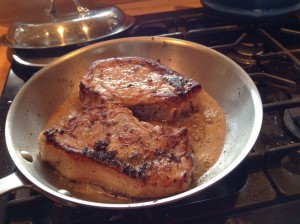
I know. Thanksgiving was only last week. There are still turkey leftovers in the back of your fridge. But while the turkey was taking center stage on that holiday table, many of us farmers were also bringing in the last of the pig harvest, and our freezers are now stocked with totes full of pork roasts, fresh sausages and those delicious and all-too-often misunderstood pork chops.
As a young cook learning how to prepare meat, I found that chickens and turkeys were relatively easy to master in my home kitchen. Pork roasts, with the assistance of a meat thermometer, were also a breeze. With a little practice I was able to properly prepare beef and lamb…but the pork chops were the last cut for me to master.
That’s because these cuts came with a challenging history. They’ve been plagued with hostile media coverage that maligned their juicy fat cover, and accused them of harboring all sorts of nasty food-borne pathogens if they weren’t incinerated before serving.
The grassfed movement, with its offering of pastured pork, has made great strides in recent decades to remedy our national pork chop problem. By restoring older genetics and better feeding practices, we’ve recovered the flavor and marbling that was lost to the factory-farmed pig. We’ve educated our customers about the importance of not over-cooking good, clean meat. We’ve countered every anti-fat campaign with evidence about the importance of reintroducing sustaining, nutrient-dense animal fats to our diets.
Still, there is much more we can learn about the pastured pork chop, both in terms of the variety of the cuts, and best cooking methods.
Porcine Culinary Anatomy
While many folks simply assume “a pork chop is a pork chop,” where it comes from on the pig will determine how you prepare it.
Sirloin Chops
The cuts closest to the hip of the animal are called sirloin chops, and typically have a bit of hip bone in with the meat. Because they have a higher bone-to-meat ratio, these are often sold at a slightly discounted price. However, they also happen to be among the most flavorful (thus, some farmers, like ourselves, might simply pull them from the sale counter at the get-go, keeping these cuts for ourselves, while we let our customers have the meatier “good cuts.”). If sirloin chops are the only cuts on offer, I make sure to cook extra. While they may look large, the bone-to-meat ratio is deceiving. Like rib chops, they have a nice amount of intramuscular fat, so they will be tasty with any dry heat method.
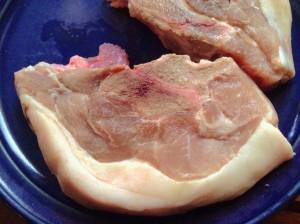
Sirloin chops have a higher bone-to-meat ratio, although the flavor and juiciness make up for it!
Loin Chops
In front of the sirloin chops are the loin chops, also called the center-cut loin chops. These cuts may be boneless, or they may have the t-bone in the center, making them the pork equivalent of a t-bone or porterhouse steak. If cooked properly, loin chops are the most tender cut on the whole carcass. They are also the leanest. Thus, they are easily made dry and chewy if mishandled in the kitchen or out on the grill. If I happen to grab center-cut loin chops, I am more likely to prepare them with a flavor brine. While brining is not necessary with pasture-raised pork, it does add a fun flavor dimension, and the sugars of the brine will adhere to the surface of the meat, aiding browning. Furthermore, brining serves as an insurance policy against dry meat if you run the risk of over-cooking it, which is easy to do with loin chops. If you are inclined to episodes of absent-mindedness in the kitchen (such as forgetting about the pork chops while you correct your kids’ spelling quizzes or answer the phone…), flavor brining is a very helpful step for guaranteeing success.
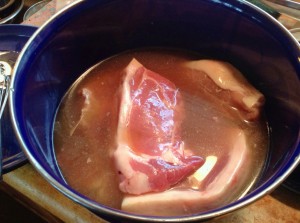
Loin chops in a simple flavor brine of maple sugar, sea salt and water. See the recipe below.
Rib Chops
Moving forward once more on the pig, we come to the rib chops, which are the pork equivalent of a rib eye steak. These cuts have significantly more intramuscular fat (marbling), which aids in keeping the meat surrounding the bones silky and tender, even if they are over-cooked. Their abundance of fat makes them a much safer bet for inexperienced cooks. If I am lucky enough to score a pack of rib chops, my work is easiest of all. I can simply sprinkle the chops with salt and pepper and toss them on the grill with little worry, even if they get slightly over-done.
Shoulder Chops
Farther forward on the pig, in the shoulder primal, we can find the shoulder chops. Since these cuts contain more connective tissues, they are usually cooked with a moist-heat method, such as braising or smoking. While they can be cooked directly over a grill flame, they are not going to be as tender as the conventional pork chops. Please see any of my other cookbooks, The Grassfed Gourmet, The Farmer and the Grill, or Long Way on a Little , for recipe ideas for shoulder chops.
But what about those food-borne pathogens?
When cooking pork, it is imperative that you monitor the internal temperature of the meat. As long as the chops are cooked to a minimum internal temperature of 137 degrees F., the temperature at which Trichinella spiralis are killed, you can be assured you won’t contract trichinosis. I recommend cooking pork to 145 degrees for rare, and 160 for well-done.
Salmonella bacteria are also easy to thwart. According to Texas A&M Extension service, exposing meat to cooking temperatures above 150 degrees F. is enough to kill Salmonella bacteria. To clarify, that doesn’t mean that the internal temperature of the meat must reach 150 degrees, only that the frying or grilling temperature be set at a minimum of 150 degrees. Most conventional ovens do not go below 170 degrees, and typical frying and roasting temperatures are around 300 degrees. Thus, so long as you are choosing to cook your pork chops and not eat them raw, you should be safe from Salmonella contamination. Do remember, however, the essential kitchen caveat to not prepare any foods that will be served un-cooked using utensils that have been used to handle raw meat.
If you scroll down further, you’ll find three recipes to get you started with proper pork chop cooking techniques. The first one teaches how to properly pan sear, the second teaches how to use a flavor brine, and the third recipe gives basic instructions for preparing pork chops on the grill. With these three recipes, you should be able to successfully prepare any sirloin, center-cut loin or rib chop so that it is juicy and flavorful…and perhaps give yourself a nice reprieve from turkey leftovers!
This essay was written by Shannon Hayes, whose blog, RadicalHomemakers.com and GrassfedCooking.com, is supported by the sale of her books, farm products and handcrafts. If you like the writing and want to support this creative work, please consider visiting the blog’s farm and book store.
To view Ula’s Greeting Cards and support Saoirse and Ula’s (Shannon and Bob’s kids) entrepreneurial ventures, click here.
Feel free to click on any of the links below to learn about Shannon’s other book titles:


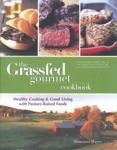
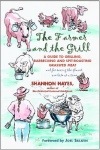

Pan-Seared Pork Chops
This recipe is taken from my most recent cookbook, Long Way on a Little: An Earth Lover’s Guide to Enjoying Meat, Pinching Pennies, and Living Deliciously.
I never had very good luck turning out a consistently juicy and tender pan-cooked pork chop until I came across this technique, adapted from Bruce Aidell’s Complete Book of Pork. Now I have success every time.
Serves 2-4
2 bone-in pork rib or sirloin chops, 1¼-inches thick
3 large cloves fresh garlic, 1 minced and 2 peeled but left whole
2 teaspoons dried thyme
2 teaspoons ground black pepper
1 tablespoon coarse salt
4 tablespoons butter, 2 melted, or 2 tablespoons melted butter and 2 tablespoons lard
1 cup Meat Broth, such as Shannon’s Meat Broth, Chapter 3
2 tablespoons bourbon
1 teaspoon Dijon mustard
2 tablespoons heavy cream
Blot the chops dry. Stir the garlic, thyme, black pepper and salt into the melted butter. Brush this on the chops and allow them to come to room temperature. Put the whole garlic cloves and broth in a small saucepan. Bring it to a simmer until the garlic is soft and the broth is reduced by half, about 15 minutes. Turn off the heat.
Meanwhile, heat a skillet that is large enough to hold two pork chops without crowding them over a medium-high flame. Add the remaining butter or lard and swirl to coat the pan. Add the chops and sear 2-3 minutes, or until browned on the bottom. Turn and cook 2 minutes longer, then reduce the heat to medium-low. The chops should still be sputtering. If you don’t hear this sound, the heat is too low, and your chops run the risk of sweating, which causes them to dry out. Once you hear a gentle sizzle, cover and cook until the chops reach an internal temperature between 145-to-160-degrees, depending on how done you like them, about 10 minutes. Transfer the chops to a platter and allow the meat to rest while you prepare the pan sauce.
Using a fork, thoroughly mash the softened garlic into the reduced broth. Return the skillet to a medium flame. Pour in the garlic reduction and bring it to a simmer, gently scraping up the browned bits from the pan. Simmer until the liquid is reduced by one third. Stir in the bourbon, simmer a minute more, then whisk in the mustard and cream. Pour over the chops and serve.
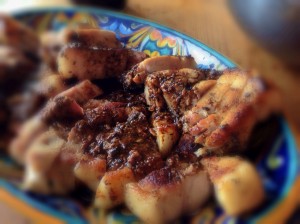
Brined Pork Chops in Rosemary Cream Sauce with Caramelized Pears
This recipe is taken from my most recent cookbook, Long Way on a Little: An Earth Lover’s Guide to Enjoying Meat, Pinching Pennies, and Living Deliciously.
This recipe calls for center-cut (loin) pork chops, because the brining process helps to balance out their leanness when frying. If you only have rib chops or sirloin chops, feel free to use them.
Serves 2
1¾ cup water
2 tablespoons coarse salt
3 tablespoons granulated maple sugar, turbinado, sucanat or brown sugar
2 center-cut/loin/t-bone pork chops, 1 ¼-1 ½ inches thick
3 pears (any variety that is in season and ripe will do), peeled, cored and thinly sliced
2 tablespoons butter
1 tablespoon lard (or butter)
1 cup dry white wine or Meat Broth, such as Shannon’s Meat Broth, Chapter 3
½ teaspoon dried rosemary
3 tablespoons sour cream
Fine salt and pepper, to taste
In a medium bowl, whisk together the water, salt and maple sugar. Add the pork chops, cover, and refrigerate 4-6 hours. Remove the chops from the brine, rinse well, and pat dry. Discard the brine. If you are not cooking the chops right away, wrap them in plastic or put them in an airtight, covered glass container and store them in the refrigerator for up to two days.
When you are ready to cook the pork, let it come to room temperature for at least 30 minutes. Melt the butter in a medium non-reactive (stainless steel or enameled) skillet over a medium-high flame. Add the pears and sauté 2 minutes, stirring often. Turn the flame down slightly and cook slowly until the pears are caramelized, stirring occasionally, about 15 minutes.
Meanwhile, prepare the pork chops. Melt the lard or remaining butter in a skillet large enough to hold the chops without crowding over a high flame. Thoroughly pat the chops dry and add them to the skillet. Cook 2-3 minutes or until lightly browned on the bottom. Turn and cook 2 minutes longer, then reduce the heat to medium-low. The chops should still be making a gentle sizzling sound. If you don’t hear this sound, the heat is too low, and your chops run the risk of sweating, and thus drying out. Adjust the heat accordingly, cover, and cook until the chops reach an internal temperature between 145-160-degrees, depending on how done you like them, about 10 minutes. Transfer to a platter and allow the meat to rest while preparing the pan sauce.
Pour off the excess fat from the pan and return it to a medium-high flame. Add the wine or broth and rosemary. Bring to a boil, using a whisk or wooden spoon to scrape up any browned bits that are stuck to the bottom of the pan. Simmer until the liquid is reduced by half and syrupy, about 5 minutes. Turn off the heat. Whisk in the sour cream, season to taste with salt and pepper, and pour the pan sauce over the chops. Serve with the caramelized pears spooned onto the side.
Salt and Pepper Grilled Pork Chops
This recipe is adapted from my grilling cookbook, The Farmer and the Grill.
I used to believe pork chops always required fancy herbal seasonings, until one day I had grilled pork chops at the farm, cooked by my dad. I raved about the seasoning the entire evening, and pleaded with Dad to tell me his recipe. He said nothing the whole night, until I was walking out the door, at which point he called out “Salt and pepper!”
Remember: The most important consideration when grilling pork chops is to not over-cook them. Even if you are acustomed to well-done pork, keep these chops on the rare side of medium, not letting the internal temperature rise above 145 degrees. This will keep the meat juicy and flavorful.
Serves 2
Coarse salt, to taste
Ground black pepper, to taste
2 pork rib, sirloin or center-cut loin chops, roughly 1 1/4 – 1 1/2 inches thick
Blot the pork chops dry, then sprinkle them liberally with salt and pepper and allow them to come to room temperature while you prepare the grill.
Heat one side of the grill to medium-high. You should be able to hold your hand five inches above the grate for no more than four seconds. Lay the chops directly over the flame and grill, with the lid off, for 2 minutes per side. Move the chops to the cool side of the grill and cook, covered, for 7-10 minutes longer, without flipping, until the internal temperature of the meat registers between 137 and 145 degrees. Remove them to a platter, and allow them to rest for a minute or two before serving to allow the juices to redistribute.
Thank you for sharing these pork chop recipes. I too have found chops to be difficult at times- sometimes tough or dry and sometimes juicy and tender.
Hi Shannon, thanks for sharing your recipes. They look delicious. It’s incredible what we’ve done to food in the name of “progress”, isn’t it. I remember buying pork tenderloin (the inner part of the pork loin chop) for 50 cents a kilo because no one knew what to do with it. We bought it from the delicatessen instead of the butcher because it wasn’t really seen as “real meat”. Getting animals back to a natural environment where they eat grass and have sun on their backs gives the animals a better life and us better food.
These recipes sound interesting,but I still have very fond memories of tender and scrumptious braised pork chops, with the heavenly gravy (lots of onion, salt and pepper) made from the pan juice. I even loved the pork chop fat!
Berkshire breed of pigs have more inter-muscular fat and thus juicy pork even fully cooked. But I cook my pork to 145 degrees Enjoyed these recipes!! Dawn